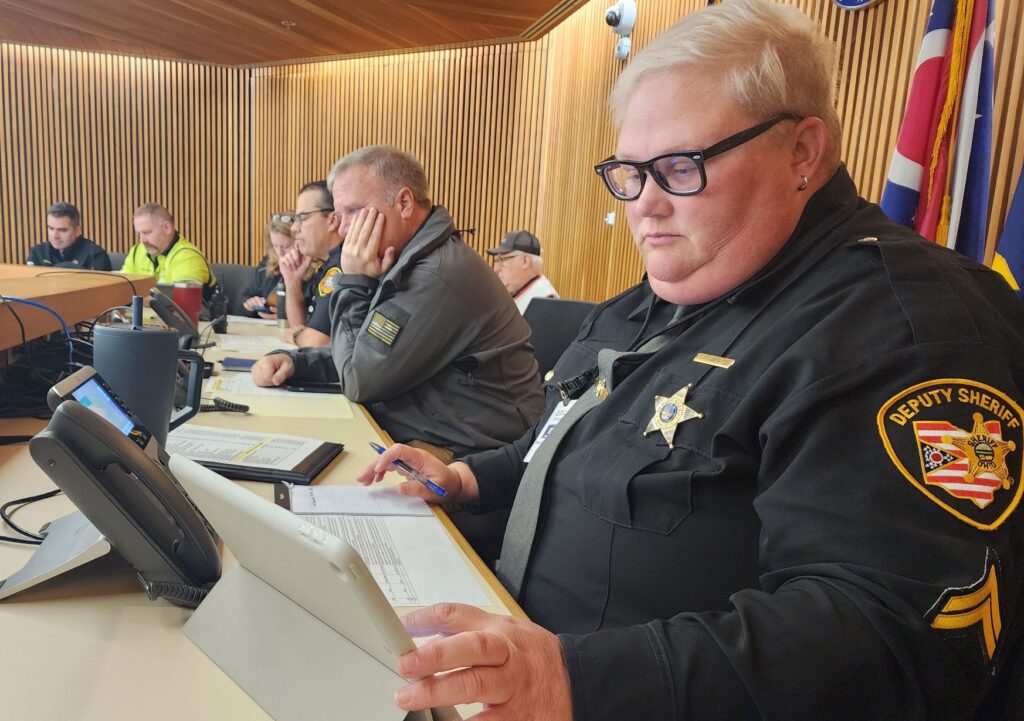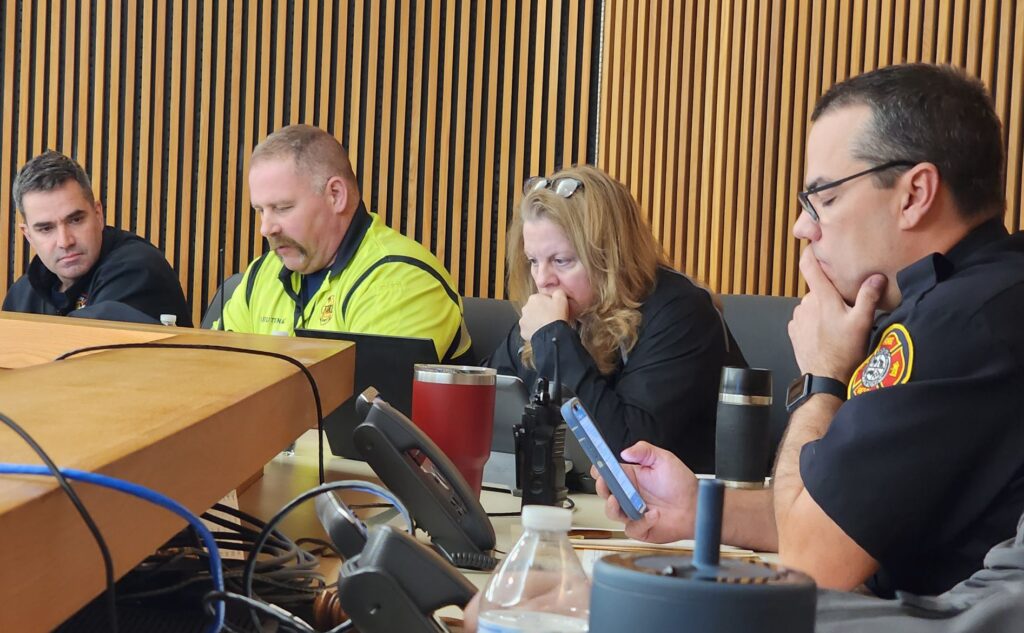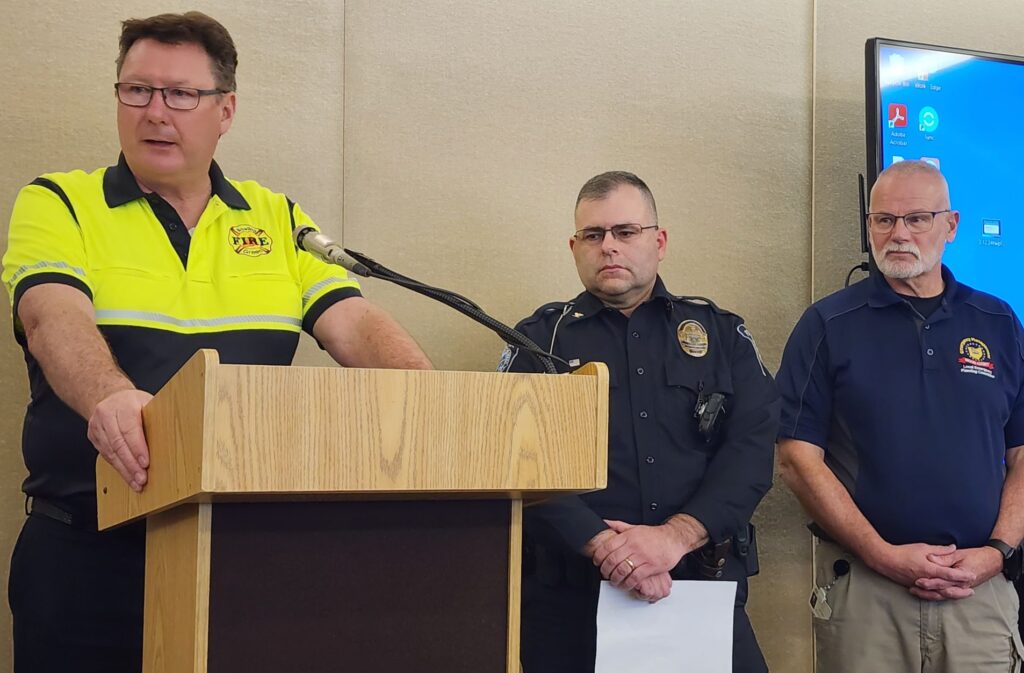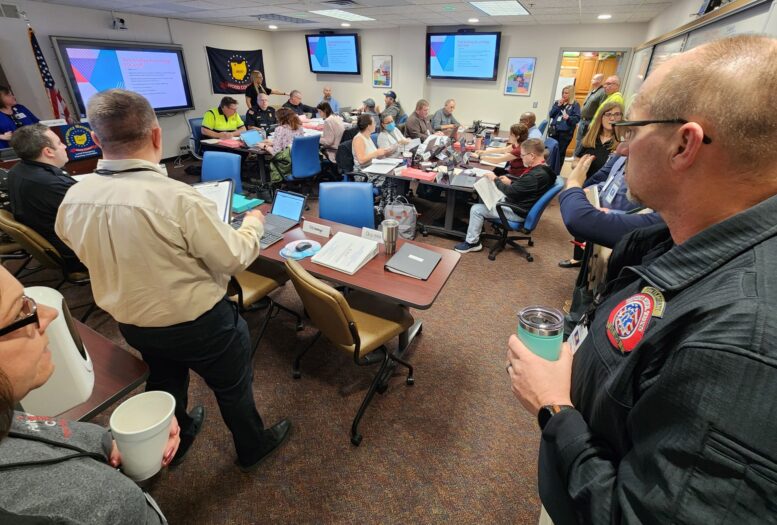By JAN McLAUGHLIN
BG Independent News
Practice makes perfect … or at least pretty darn close.
For four hours Wednesday morning, first responders from the area handled a fake hazardous material incident that could have been deadly for those nearby, required the evacuation of thousands of residents, and created panic across Bowling Green.
The drill began with a report of a train car stopped on the CSX tracks through town after it was realized the tanker was releasing vapors from the top and leaking liquid from the bottom. That sent more than 80 first responders into high gear as they tested the response plan for a disaster of such magnitude. Every phone call and radio transmission began with the words, “This is an exercise,” to make sure people hearing the traffic didn’t mistake the disaster for a real event.
So how did it start?
The leaking tanker car was stopped near the BGSU parking lot between Ridge and Pike streets. Firefighters noted a strong sweet smell coming from the railcar, and reported that there were several apartments and homes in the nearby area.
The placard on the railcar identified the contents as styrene monomer – nothing to mess around with, according to EPA and CSX officials reached by phone. The railroad representative reported that the tanker had a full load of 22,530 gallons of the hazardous chemical. If humans come in contact with the vapors, they may suffer burning skin and eyes, dizziness and serious respiratory problems.
The wind direction and speed were checked, and it was ordered that an evacuation zone be created within 300 meters in all directions from the leak.
Streets surrounding the hot zone were shut down, and officials reported they were already running out of barricades.
Gradually more and more information trickled in from different sources to get more of a complete picture of the hazard – and it didn’t look good. The city needed more law enforcement to help with the evacuation, more firefighters to take shifts trying to keep the tanker cool, hazmat specialists to operate a decontamination zone at the airport, and drones from the sheriff’s office.
They needed the EPA to monitor the air, the Red Cross to set up and staff an evacuation site, transport to the hospital for an “officer down” at the scene, and somebody had to deal with the rush of media to the city.

Takes a turn for the worst
As if the situation wasn’t bad enough, mid-morning a phone call came in from CSX – the tanker full of styrene monomer has “inhibitor” in it – but it’s expired. The chemical, which can be deadly if inhaled, has a flashpoint at 40 degrees.
That turned a dangerous situation into a nightmare.
The previous evacuation zone bordered by East Court, North Prospect, Ridge and Pike streets was no longer good enough. The zone was stretched to 800 meters in each direction, to Lehman Avenue, Fairview Avenue, Poe Road and Willard Road.
The new information about the highly explosive nature of the liquid meant the current evacuation site at the BGSU Union was no longer safe. The Red Cross scrambled to relocate the evacuation site to the BGSU Stroh Center.
Because of the explosive nature of the chemical, requests were made to shut down electricity and gas to the area.
Though firefighters were cooling the tank with water, there was still a “slight possibility of an explosion.”
Some people on the BGSU campus – estimated as a couple hundred – decided to shelter in place, rather than go to the Stroh Center. All heating and ventilation had been shut off to campus buildings to prevent dangerous fumes from entering.
Downtown businesses, at least on North Main Street, had been asked to shut down and evacuate. Some complied, some did not.

Who got to play along?
To respond to the crisis, the Wood County Emergency Operations Center in the county courthouse was packed with people representing fire departments, EMS personnel, hazmat specialists, EMA, utility officials, highway workers, BGSU, Wood County Health Department, and people to help with responses for schools, senior citizens, and those with mental health issues.
While those in the first floor EOC implemented a response plan, other participants were on the fifth floor of the county office building, calling in or receiving reports as the situation escalated.
Those people included representatives of fire, hazmat, dispatching, Red Cross, CSX, EPA, area hospitals, ham radio operators, and the media.

Can’t ignore the little stuff
So in addition to dealing with the leaking railcar and evacuation of thousands, someone’s got to handle all the panicked people. Dispatchers reported getting a ton of calls – many of them from parents worried about their children at BGSU.
A call comes in from a worker at a group home near the tracks. Is it safe to drink the water? How can she safely get the residents to the evacuation site?
Then comes a call from a pizza delivery guy from a nearby pizza place, reporting that a sink hole just showed up in front of the business.
And of course the media wants to get the scoop fast. In this scenario that led to one reporter getting arrested after refusing to leave the “hot zone.” Another checked on rumors that the incident was “terror related.” And one media person inquired about the “atrocious safety record” of CSX.

When it was all over
Before the “hotwash,” when people involved in the tabletop exercise discuss what was good and what could have been better, some key people had to go through a “press conference” with reporters.
Bowling Green Fire Chief Bill Moorman handled the bulk of the questions – using the podium to stress that people stay away from the contaminated area.
“We need everybody to listen,” he said.
While there were several people injured at the scene, there were no fatalities, Moorman said.
“We want to keep it that way,” he said. “We need people to stay out of that explosion zone.”
The chief told local residents to not go to the local hospital, since it was on bypass due to a couple contaminated individuals seeking help there and contaminating the site. Anyone feeling symptoms should first go to the decontamination site at the county airport, he said.
At four hours in, the incident was far from over.
“We’re going to be working into the night,” Moorman said.
The cleanup company had not yet arrived on site, so meanwhile air samples will continue to be taken, wind speed monitored, and the tanker cooled with water.
The only school in the evacuation zone was St. Aloysius, which according to the plan was in the process of evacuating. Other schools had been notified and were planning to send students home early.
After the press conference, organizers of the exercise said they were pleased with how the emergency plans were followed.
“We always hope something like this doesn’t happen,” said Erin Konecki, deputy director of Wood County EMA. “It’s never going to be perfect.”
Such drills are meant to identify weaknesses in emergency responses.
“It’s good to have those little mistakes during a training exercise,” rather than a real event, Moorman said.
Tabletop drills can expose problems that don’t show up on written plans.
“A lot of things look great on paper,” said Wood County EMA Director Jeff Klein. “I think we learned some things today.”





